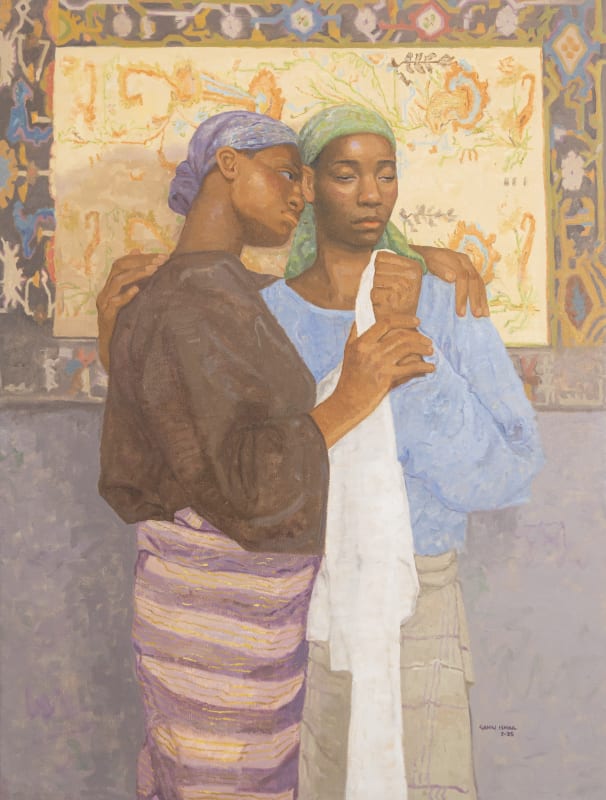The Ties That Bind is a strongly contrasting exploration of love, loss, longing, desire, and despair.
The Ties That Bind, featuring works from Lagos based artists Afeez Onakoya and Ganiu Ismail, is a strongly contrasting exploration of love, loss, longing, desire, and despair. The figurative paintings of both artists illustrate how this range of emotions contributes deeply to the human experience, forming ties that keep us in community with others. While Onakoya’s In Love We Thrive focuses mainly on the “love that exists within a relationship – between friends, families, and especially among men”. Ismail’s Holding Memories looks into the collective human experience and how objects such as textile, can be “a space to trap in memories”. Despite their different approaches, these two series portray how touch is essential to affection and companionship.
In Onakoya’s Aro Meta (2025), three male figures pose against a blue background, their bare backs to the viewer. Their toned arms stretch out to interlace one another, and their identical appearance echoes the concept of the trinity. Note how their dark limbs stand apart but their torsos are one – like three candlesticks producing a uniform, larger flame out of conjoined wicks, exemplifying the strength in community. If the men’s camaraderie is apparent in this painting, Onakoya takes a more subtle approach in Blue Silence II (2025), where the figures touch each other with the slight coupling of two fingers. These gestures – a firm grip and a hesitant touch – reveal two observations in the male approach to companionship: a show of affection can be heavy-handed in play but somewhat more concealed in intimacy.
By contrast, Ismail’s series features only women and presents companionship in an assured manner. In Ladies with Shroud 1 (2025), two women stand against a wall that is grey at the bottom and the top half adorned with a tapestry. They are dressed in lightly coloured bubas and dark-hued wrappers. The woman on the left has her head on her companion’s shoulder and one hand on her companion’s chest. Their eyes look beyond the frame, their faces bearing expressions that seem hard to read. What appears is a hint of melancholy, but at the same time, they seem at ease, as if, despite their mood, their relaxed embrace and togetherness cannot be upset by anything in the world. Ismail takes this assuredness further in the paintings where the women are alone, interacting with an object that probably belongs to a companion. Consider Lady with Shroud (2025), in which a woman in a blue buba and maroon wrapper stands by herself. Her nostalgic expression is unequivocal, and her mien suggests that the texture or smell of the fabric pressed against her cheek evokes something in her, most likely the memory of a person or a place. Here, memory becomes a companion held tenderly, too.
Both painters, dissimilar in style and approach, speak to the same theme of community, be it amongst friends or family. They communicate this in their own language, through different worlds they have created. For Onakoya, the use of strong tones, the sense of divinity, and the presence of immaculately chiselled figures put the viewer in a space reminiscent of the world of heroes from Greek mythology. For Ismail, the serene and pastoral ambience, the soft tones and colourful fabrics, present a fairytale feel that calls to mind the world of Disney animations. In these worlds they have created, these artists make room for the idea that amid the harsh climate of the outside world, the worsening economic conditions and divisive politics, there are alternative realities we can escape to, realities we can meet and be at ease, realities that reinforce togetherness.


